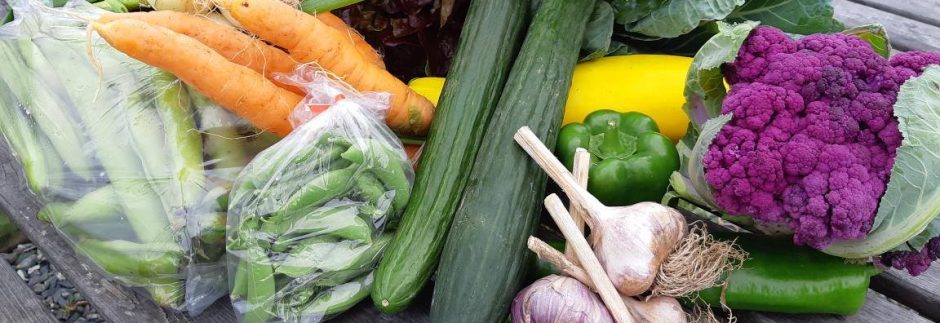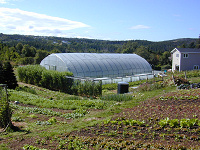Veggie Coop Farm Notes
WEEK 2: July 1, 2013
WHAT TO DO IF YOU CAN’T MAKE PICK UP!
Please e-mail Mike ahead of time or call the house (895-2884) or Farm Cell: 689-7693 before 5 pm. We will leave the bag of veggies behind in the Farm Chill room and you can pick up at the farm at your convenience. If you are out of town and let us know before the bags are packed, you can request a replacement bag at the end of the season. If, however, your bag is packed and waiting in the chill room, we will give the veggies to someone else after a reasonable period of time or if it is early in the season and veggies are sparse, we will capture the abandoned vegetables and use them ourselves in the family kitchen.
One Down and 16 to Go!
Things are going pretty well, but we did have to wait for people who did not pick-up by 6:30, something we want to avoid especially if it is raining and cold like last week. What we learned is that some people come late intentionally because they don’t like waiting in line; however, if that is your game plan and everyone gets there on time, this means that Mike winds up waiting for you. Please try to arrive at the pick-up by 6:25.
WHAT’S IN THE BAG!
Rhubarb, chard or spinach, lettuce Chinese cabbage, green onions or chives, etc. This early in the season, you will be getting early season vegetables, mostly greens and there probably won’t be many surprises. The herb for Monday is oregano. Not sure about Wednesday as some of the items will vary from Monday group to Wednesday, depending on quantities. Over time, the veggies and herbs will be rotated fairly between groups. . The main differences between large and small bags will be quantities.
Rhubarb recipes are the focus for this week. There are three recipes among the extensive list appearing on the website that I would like for you to try. They are: (1) Take Them Anywhere Squares from Joyce Hansen. We made these twice over the week-end. Children can help with this simple activity. (2) Rhubarb Crisp and (3) Rhubarb Sauce from the Organic Gardener Magazine which we have been using for thirty years.
Rhubarb Sauce is Mike’s favourite from the beginning to the end of the season. It is different because it is lightly cooked and thus, remains crisp. Mike has this religiously as his main food for a late morning/ breakfast dish, adding fruit such as banana, dates or figs, maybe fresh or frozen blue berries along with yogurt. What we also like is it as a topping for breakfast cereal or over ice cream or pound cake. We usually work up the spare stalks and pieces left from picking and packing for Veggie Coop. Laura and Diane know to bring it to the back porch where our daughter, Toby, brings out the cutting boards and knives, then entices one of the farm volunteers to help prepare the next batch. Even though this is one of the oldest farm rituals like the rites of spring, we never lose the excitement of explaining how to make rhubarb sauce to our new Veggie Coop members.
Do you have a favourite recipe?
Usually, we only post recipes that we have made ourselves or they are sent in by Veggie Coop members. We have also made rhubarb punch, rhubarb sherbet and the Moist Rhubarb Coffee Cake. Last year, some one sent in a bunch of recipes which we have not used personally and they got inadvertently forwarded to the Website. When I get more time, I plan to try some of them and delete the ones we have not used. If you have any favourite recipes, please send them along, with your name and comments. Alternatively, if you use one of the other recipes posted on Website, please let us know what you think of it.
Drying Herbs
Many years ago, when our Veggie Coop members where complaining about getting more herbs than they could use, I wrote several detailed pieces encouraging people to try drying herbs. Now we send out fewer herbs at one time and this information is available with the click of your mouse; in fact, even short video discussions. There are a few things I would like to share from my experience. You can dry a little or a lot with the same amount of effort. Use a simple system, such as drying in a brown paper bag hung from a string or kept in a straw basket in the corner of the kitchen or dining room. If you make it to difficult to organize, you will probably wind up not bothering. At that time, one of the methods I recommended was placing on a paper towel on the top of the micro-wave, turning occasionally. This turned out to be a catastrophe for one coop family. If you do this, announce your new herb drying practice with a small or large sign. Here is why! Eric, the husband, saw the herbs laying on the top of the micro-wave for a few days in a row, appearing less fresh day after day. He thought his wife was being forgetful or even worse, lazy, so after a few days, he gathered them up and threw them in the garbage. You can imagine the consequences. So, find a way that you can dry and take care of your herbs in a small amount at a time.
“Keep Herbs in the Dark.” I attended a herb drying workshop at an organic conference in Halifax many years ago. This woman used a small commercial dehydrator. She advised, leave herbs no longer than you have to make sure they are thoroughly dry. Do not handle more than necessary and leave leaves and stems intact; store in the dark using a container with a lid, until you are ready to use. She kept her herbs in large glass jars on shelves in her basement. She advised, do not crunch with your fingers and move into smaller packages until you need them; this keeps the flavour and oils locked in. I keep mine in zip lock bags, inside another Tupperware like container with a lid, taking them out to replenish my herbs jars as needed. I am not able to tell the difference in using fresh and dried mint for my favourite tabouli recipe over the winter. Toby, my daughter, dries tons of mint, then packages in zip lock bags, decorates with ribbon and gives to friends as gifts the year around for making mint tea. Be sure to label each bunch of herbs with name and date; after they are dry it may be difficulty to tell one herb from another. ANY ADVICE/ DRYING HERBS, PLEASE SEND IT ALONG and you will be published in Farm Notes.
WHAT’S HAPPENING ON AND OFF THE FARM?
This is a regular column in Farm Notes when we have time. I will start it today by introducing some of the Farm Workers and explaining the WOOFING program. As you have probably figured out by now, the Organic Farm is a family farm which has unfolded over the past thirty-five years from the garden Mike put in to grow veggies for his young family. The story is that before the house was finished, I saw someone taking up the top soil from the front of the house. I was amazed, with three children, ages four, six and seven and little other land, what was happening. When I asked Mike what was going on, he said, “well that is the warmest and most protected place on the property. If we are going to have a garden, this is where it has to be.” We still have a garden, in the front yard, with a border of goose berries, planted the same year; beyond that, are 3 mint beds developed over the long, wide bare ditch, made when the Town of Portugal Cove put in water and sewer. It was a good place for Mint because it is an invasive plant and needs to be maintained as far away from other gardens as possible. To Mike’s credit, he also planted various trees in front of the house at the same time, and today, one can hardly see the front of the house because of all of the beautiful, mature trees and shrubs he had the foresight to put in at that time.
Mike and Louis are central figures in Organic Farm Operation.
Besides Mike, Louis, our oldest son, has helped from the beginning, first as a teen-ager and later as a serious organic farmer. While Mike has been focused primarily on soil development, seeds for our short season climate and best resources for effective practices in organics, Louis has developed some of our most unusual and sought after crops such as the very popular salad mix, which is one of the farm’s enigma crops along with pea shoots, edible flowers and micro-mix. On the other hand, Mike is passionate about learning methods for growing in Newfoundland with the soil and climate. When asked, he provides whatever information unfolds to back yard gardeners, community gardeners, and other wannabe organic farmers in our province. He welcomes visitors, people who are interested in growing organically, especially young people. You will hear more about this from week to week, as various projects and visits unfold over the season.
Growing With Geo-Thermal Heating Systems
Over the past three years, Mike has been exploring how to introduce geo-thermal heating into our greenhouse system. In 2010, we added geo-thermal pipes to an “old” existing greenhouse. While we were watching and learning how best to manage this, we also built a larger greenhouse, size 30 x 148 feet, which has geo-thermal pipes around the outside edges only. You will be hearing more about these challenges and if things go as we hope, also tasting some of the vegetables grown in these new systems.
You will also be learning more about the people working on the farm.
WHAT’S HAPPENING OFF THE FARM!
When we have time, we also add other things. It might be an event involving other people, such as friends or new Chefs. More than likely, our regular news will also include updates on Toby, our daughter, who is a Visual Artist. Toby is with the Leyton Gallery of Fine Arts; she also sells art shirts and art cards of Newfoundland scenes, as well as hand built clay pieces at the Devon House gift shop on Duckworth Street behind the Sheraton Hotel. She has just received the invitation to submit pieces for the St. John’s Art Procurement Program. We are scrambling to make sure we have digitals to send in for 3 pieces – and, over, the past few weeks, we have been developing a display for the Visitor Information and gift shop at Cape St. Mary’s Bird Sanctuary. More to come!
PLEASE FEEL FREE TO VISIT THE FARM. SATURDAYS ARE OUR BEST DAYS, OR OTHER TIMES BY APPOINTMENT.
Melba Rabinowitz/ the better half of the Organic Farm
July 1, 2013


 A special message from Mike Rabinowitz: Celebrating the Life of Melba
A special message from Mike Rabinowitz: Celebrating the Life of Melba